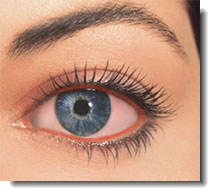
Pink Eye (Conjunctivitis): What is it?
Symptoms You May Experience:
Examination: What Your Eye Doctor Will Look For:
What You Can Do:
When To Call Your M.D.:
Treatment:
Prognosis: Will I See Better?
Conjunctivitis, aka "pink eye", is a very common condition characterized by inflammation of the conjunctiva. There are many causes, the most common of which can be grouped into two broad categories: microorganisms (viruses and bacteria, for example) and allergic reactions (medications and pollen, for example). A virus is the most common cause of pink eye.
Typical symptoms of conjunctivitis include redness of the eyes, tearing or discharge, general discomfort in the eyes, and the feeling that there is "sand" in the eye. In cases of allergic conjunctivitis itching is usually the major complaint, although other symptoms may also be present.
The most common sign in pink eye is redness over the "whites" of the eyes. There are certain signs that help the eye doctor to determine the cause. For example, does the conjunctivitis involve one or both eyes? Viral or bacterial conjunctivitis usually starts with one eye and may or may not involve the other eye several days later. Is there clear fluid or discharge draining from the eye? Yellow-green discharge suggests that there may be a bacterial cause. Is there enlargement and tenderness of the lymph node just in front of the ear on the same side as the affected eye? This often occurs in viral conjunctivitis. Is there involvement of the cornea? Small areas of corneal involvement may indicate a viral cause and lead to sensitivity to light.
The most important thing that patients with these symptoms can do is practice good hygiene. Frequent hand washing, keeping the fingers out of the eyes, and not sharing linens are very important to prevent the spread of the contagious forms of conjunctivitis to other people.
Conjunctivitis accounts for a large number of patient visits to emergency rooms as well as to medicine and eye clinics. It is important to notify your doctor if any of the following symptoms are associated with pink eye: loss of vision, drainage, eye pain, failure to get better within 1-2 weeks, or worsening of symptoms after seeing your doctor.
The treatment of conjunctivitis depends on the cause. The most common cause is viral, and the vast majority of cases will heal on their own with no treatment. Therefore, antibiotics are usually not needed to treat pink eye. Artificial tears and cool compresses may provide symptomatic relief in viral cases. Ophthalmologists may decide to treat with steroid eye drops in some instances. There are certain viruses that do have specific treatment; for example, herpes simplex virus is often treated with antiviral eye drops. There are also eye drops that are effective in treating allergic conjunctivitis.
In uncomplicated cases, patients can expect their symptoms to resolve completely after 1-2 weeks as the conjunctivitis heals. Patients with allergic conjunctivitis can usually find relief from their symptoms with prescription eye drops, although it may take several weeks to find the most effective medications. There may also be chronic low grade symptoms or seasonal flare-ups, especially if the conjunctivitis is related to substances in the air, such as pollen.

Above: Pink Eye Is Very Common.
Contact Lenses | Glaucoma | Just For Fun | Eyeglasses | Eye Doctor | Eye Care And Symptoms | Eye Anatomy | Online Eye Tests | Laser Eye Surgery | Laser Eye Surgery Directory: Canada | Laser Eye Surgery Directory: USA | Laser Eye Surgery Reviews | Submit A Review | Contact Us | Privacy Policy | Sitemap
Copyright 2006-2009 Vision Health

